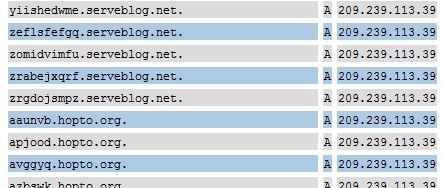Fiesta!
No, we haven't broken out the beer or decided to start the weekend early. This ISC diary isn't about party time, but rather about the "Fiesta Exploit Kit". We are recently seeing an uptick of it being used on compromised web sites.
Fiesta has been around in one form or another since 2012, when it branched off the "NeoSploit" kit, and is regularly being retrofitted with new exploits to stay effective. The first stage is usually just a redirect, to the actual exploit site from where a heavily encoded/obfuscated JavaScript file gets downloaded. This JavaScript file checks the locally installed software, and then triggers or downloads the matching exploit(s).
The currently most prevalent version of Fiesta seems to use the same five exploits / vulnerabilities since about November last year:
- CVE-2010-0188 Adobe Reader TIFF vulnerability. The code checks for Adobe Reader versions >= 800 < 821 and >= 900 < 931, and only triggers if a matching (ancient) Adobe version is installed.
- CVE-2013-0074 Microsoft Silverlight (MS13-022, March 2013). The code checks for Silverlight versions >= 4050401 and < 5120125, and triggers the exploit if applicable. Silverlight 5.1.201.25.0 is the version after patch MS13-022 has been applied
- CVE-2013-2465 Oracle Java. Of course - there had to be a Java sploit in the mix. The code checks for Java > 630 < 722
- CVE-2013-0634 Adobe Flash Player. The code checks for Flash Player >= 110000 <= 115502.
- CVE-2013-2551 Microsoft Internet Explorer (MS13-037, May 2013). The code in this case just checks for IE Versions 6 to 10, and if found, tries the exploit.
A system with reasonably up to date patches should have nothing to fear from the above. The fact that Fiesta has not widely re-tooled to newer exploits suggests though that the above set of vulnerabilities are still netting the bad guys plenty of newly exploited bots.
The existing Snort EmergingThreat signatures for Fiesta are doing a reasonable job at spotting the attack. As for the Snort standard (VRT) ruleset, rule SID 29443 seems to work well right now, it was added in January to match on the URL format: "/^\/[a-z0-9]+\/\?[0-9a-f]{60,66}[\x3b\x2c\d]*$/U" used, and is still triggering frequently on the current Fiesta wave.
One further characteristic of the current Fiesta is also its heavy use of dynamic DNS. Seen this week so far were *.no-ip.info, *.no-ip.org, *.myvnc.com, *.no-ip.biz, *.myftp.com, *.hopto.org and *.serveblog.net. These are DynDNS providers, so obviously not all sites hosted there are malicious. But Fiesta is making extensive use of these services to rapidly shuffle its exploit delivery hosts. The host names used are random character sequences of 10 or 6 chars, current example "ofuuttfmhz.hopto.org". The corresponding sites are sometimes active for less than a hour before the DNS name used in the sploits changes again.
What seems to be reasonably static are the IP addresses - 209.239.113.39 and 64.202.116.124 have both been used for the past two weeks, and the latter hoster seems to be particularly "popular", because the adjacent addresses (64.202.116.122, 64.202.116.125) were in use by Fiesta in late January. Also quite common are landing pages hosted on *.in.ua (Ukraine) domains, like ujimmy.in.ua, aloduq.in.ua, etc. These domains should be infrequent enough in (western) web proxy logs to make them easier to spot.
If you have any other current Fiesta intel (not involving cerveza :), let us know via the contact page or comments below!




Comments
Great write-up and information, especially on the exploit delivery portion. The IPs are extremely useful too.
Just want to clear up a point or two on this, especially on the misunderstanding that this forked from NeoSploit and how long it has been around.
First, calling it NeoSploit is my mistake. I was rather persistent on it being NeoSploit after hearing that it may be NeoSploit v2 returned from the grave, until I was shown that it was fiesta kit from the admin page. I kept with the name for quite a while (see below). There is great research out there on NeoSploit and the functionality it used, if memory serves it was and has been a completely different beast than Fiesta kit. I could be mistaken, it has happened before though.
Second, it has been around for a bit longer than 2012. I think our first encounter was in May 2011, and got around to making a blog post on it in July 2011. I apologize in advance, after reading through some of the posts my writing is terrible.
The blog is here:
http://demon117sec.blogspot.com/search/label/NeoSploit
Thanks for the post, info, and the hard work that is done to keep the Internet safe.
Paul
@demon117
Anonymous
Mar 5th 2014
1 decade ago
Anonymous
Mar 12th 2014
1 decade ago